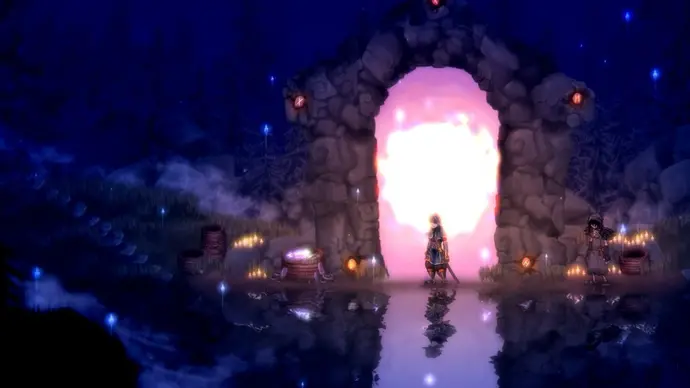
The excellent arsenal of combat customization offered by Ska Studios’ Salt and Sanctuary sequel is let down by some flimsy storyline.
Dark Souls was first brought to me by a buddy of mine. The current classic from FromSoftware, an endlessly exhaustive game about mankind and what it means to live and die, was instead presented to me as “look at this hard as shit game, bet you can’t even beat the first boss.” They were correct; I was unable to defeat the Asylum Demon, who seized my terrified figure from a ledge and splattered them all over the lower level.
That companion is Salt and Sacrifice. Ska Studios’ follow-up to 2016’s Salt and Sanctuary is a 2D side-scrolling hack-and-slash game set in the ruins of a decaying world. It pits your pathetic adventurer against monsters of enormous, hulking shapes and sizes, challenging you to venture out into the wider world and actually eat mages alive in order to restore balance throughout the land.
Similar to that friend, Ska Studios’ follow-up is primarily a cursory examination of the genre of game it parodies. NPCs and other side characters serve the player character and further your goal to repair the universe, but that’s about it. There is no subtlety in the conversation or plot. All that’s left is an unflappable combat system that serves as the basis for everything.
That being said, the fighting mechanism is not at all horrible. The protagonist of Salt and Sacrifice leaps and ducks from a barrage of hostile blows, or he can stand tall with a shield. The game encourages you to assault, but your stamina is extremely limited. In combat, there are some very suspenseful moments when you have to try to hit an adversary or sneak a heal in just in time to avoid being hit by their strike.
It may be extremely, really difficult throughout. In Salt and Sacrifice, you’re likely to get combo-attacked to death by two or more adversaries, leaving you with no means to escape, as your stamina doesn’t replenish while you’re receiving damage. There are plenty of enemies here that are taller than you, and they have the ability to launch you into the air for two or three consecutive hits, much like a protagonist from Devil May Cry, or launch you flying back over half the screen while their henchmen close in on you.

Despite its tough exterior, Salt and Sacrifice is not overly cumbersome. Actually, the protagonist of Salt and Sacrifice and their gear have an astounding level of personalization. You can use elemental damage-infused daggers to slowly eat away at your enemies’ health, spatter them with massive weapons, or use ranged spells based on ice or lightning to attack them. Because Salt and Sacrifice causes item drops from defeated foes to come in an unexpectedly large and quick stream, you’ll frequently find yourself with an abundance of things to modify and customize your weapons.
It’s only fitting that Salt and Sacrifice allows you to play with its arsenal of weaponry considering how vicious some of its boss battles can be. The enormous mages who make up the early-game monsters are all the size of houses and are skilled at hitting you with a barrage of magical assaults, such as lightning, fire, ice, and poison. When you combine massive bosses with a small 2D arena for combat, you’ll get terrifying encounters where you may be only millimeters away from a strike that would send your hero to the death.

You can only chip away at the enormous amount of health that the rogue’s gallery of monsters possess while swerving and avoiding an unending barrage. Given that there is no way to block them with a shield or to stand at the perimeter of the arena and attack them with a ranged weapon, boss battles can occasionally feel a touch unjustly weighted. Salt & Sacrifice’s monsters appear to be saying, “Good luck if you’ve been playing defensively up until now,” as the newest behemoth lumbers toward you and unleashes assaults strong enough to level structures.
Ska Studios’ follow-up is powered by a tight, intense fighting system with tons of customization possibilities, but the plot falls short of expectations.
The goal of the game is to eat the aforementioned magicians alive and cure the planet (via very mysterious ways), hence they play a crucial role in Salt and Sacrifice’s narrative. Putting aside the questionable ethics of eating someone alive, the storyline is where a lot of Ska Studios’ follow-up fails: there are too many loose ends, with each character in the game’s main environment acting as a voice actor explaining everything to you in the most obvious way. It seems like almost everyone is merely there to explain things to you; very few actually have a personality or a purpose other than acting as informational museum pieces. The setting and breadth of the original Salt and Sanctuary may be expanded in Salt and Sacrifice, but the meaning remains unchanged.

Beyond the dull central area, exploring Salt and Sacrifice’s several biomes is still a lot of fun. Consider the beginning region, a monster-filled hamlet that looks nearly totally horizontal at first. However, after you obtain the grappling hook, it transforms into a vertical playground that allows you to practically soar to new heights and explore gloomy dungeons and houses littered with dead bodies. When you’re not getting beaten off cliffs by beasties, Salt and Sacrifice’s many worlds provide a surprisingly large degree of verticality, which makes for an incredibly fun experience.
A play on previous works, Salt and Sacrifice is not totally successful. The sequel from Ska Studios features a tight, intense fighting system with tons of customization possibilities, and boss battles are fun even if they can be too difficult at times. However, Salt and Sanctuary’s narrative ideas and storytelling fall short of expectations.